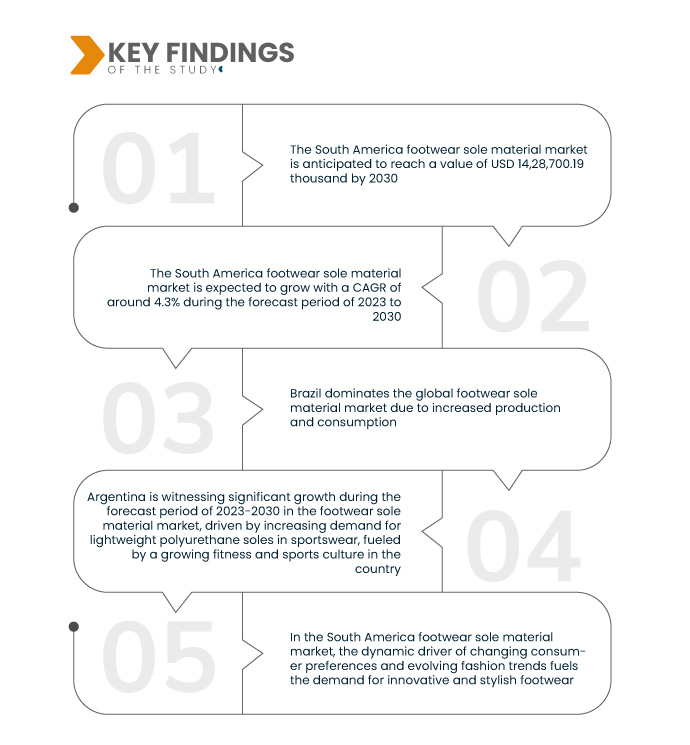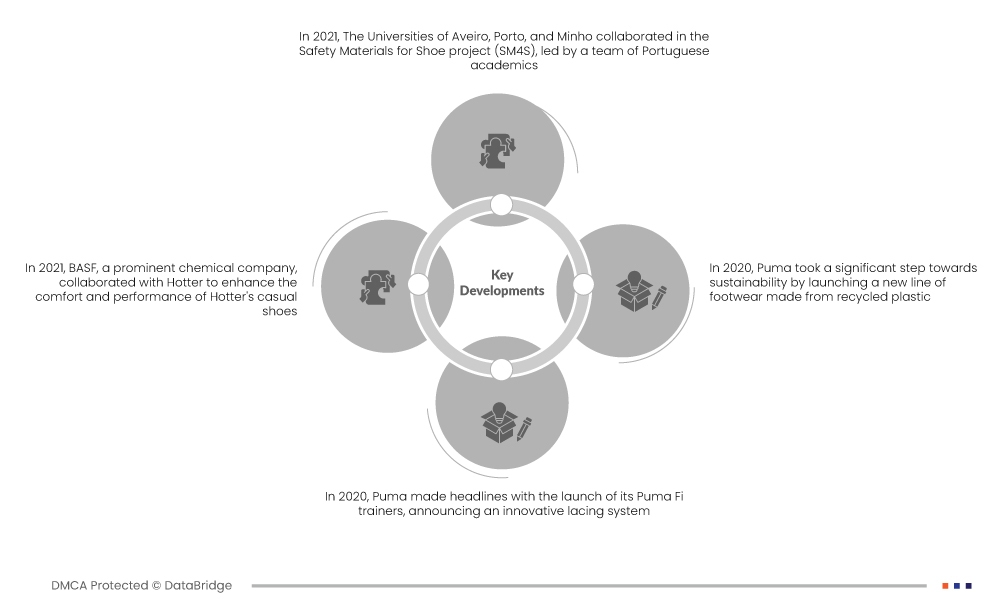ترتبط أهمية مادة نعل الأحذية ارتباطًا وثيقًا بالصحة والاعتبارات التقويمية. يلعب اختيار مادة النعل دورًا محوريًا في صحة القدم، إذ تُسهم النعال الداعمة والمُبطنة جيدًا في تقليل إجهاد القدم. يُسهم اختيار مادة النعل بعناية في صحة العظام من خلال توفير الدعم والتوسيد المناسبين، مما يُقلل من خطر الإصابات وعدم الراحة المرتبطين بالارتداء لفترات طويلة. سواءً في الأحذية الرياضية أو اليومية، يُمكن لمادة النعل المناسبة أن تُعزز صحة القدم، وتوفر بيئة مريحة وداعمة لها.
يمكنك الوصول إلى التقرير الكامل على https://www.databridgemarketresearch.com/reports/south-america-footwear-sole-material-market
تُحلل شركة داتا بريدج لأبحاث السوق سوق مواد نعال الأحذية في أمريكا الجنوبية ، والذي بلغ 10,20,156.11 ألف دولار أمريكي في عام 2022، ومن المتوقع أن يصل إلى 14,28,700.19 ألف دولار أمريكي بحلول عام 2030، بمعدل نمو سنوي مركب قدره 4.3% خلال الفترة المتوقعة من 2023 إلى 2030. يُعدّ نمو ثقافة الرياضة واللياقة البدنية في أمريكا الجنوبية عاملاً رئيسياً في نمو سوق مواد نعال الأحذية. ويعزز ازدياد المشاركة في الأنشطة الرياضية الطلب على الأحذية الرياضية المتخصصة، مما يزيد الحاجة إلى مواد نعال متطورة توفر راحة ودعماً وأداءً فائقين، مما يؤثر على نمو السوق.
النتائج الرئيسية للدراسة
من المتوقع أن يؤدي الطلب المتزايد الذي يغذي التركيز المتزايد من جانب المستهلكين إلى دفع معدل نمو السوق
من أبرز العوامل المحفزة لسوق مواد نعال الأحذية في أمريكا الجنوبية الطلب المتزايد، الذي يغذيه تركيز المستهلكين المتزايد على الراحة والأداء في اختياراتهم من الأحذية. يُولي المستهلكون المعاصرون الأولوية للتبطين الفائق، وامتصاص الصدمات، والمتانة في أحذيتهم. يُؤدي هذا التوجه إلى زيادة الطلب على مواد النعال المتطورة لتلبية هذه التوقعات. ويستجيب المصنعون لهذا التوجه من خلال تطوير ودمج مواد وتقنيات مبتكرة في نعال الأحذية، بهدف توفير تجربة مريحة وعالية الأداء.
نطاق التقرير وتقسيم السوق
مقياس التقرير
|
تفاصيل
|
فترة التنبؤ
|
من 2023 إلى 2030
|
سنة الأساس
|
2022
|
السنوات التاريخية
|
2021 (قابلة للتخصيص حتى 2015-2020)
|
الوحدات الكمية
|
الإيرادات بالألف دولار أمريكي، الأحجام بالوحدات، التسعير بالدولار الأمريكي
|
القطاعات المغطاة
|
مادة النعل (نعال الأحذية البلاستيكية، نعال الأحذية المطاطية، نعال الأحذية الجلدية، المركبات الحيوية، الخشب المقطوع، مواد أخرى)، مكون النعل (النعل الخارجي، النعل الداخلي، النعل الأوسط، النعل الموحد)، المنتج (مادة نعل الأحذية الرياضية، مادة نعل الأحذية غير الرياضية، مواد أخرى)، قناة التوزيع (عبر الإنترنت، غير متصل، مواد أخرى)، المستخدم النهائي (رجال، نساء، أطفال)، نوع النعل (نعال جديدة، نعال إصلاح)، الصناعة (صناعة الزراعة، الصناعة الكيميائية، صناعة البناء، صناعة المعادن، الصناعات الغذائية، صناعات النقل، صناعة الأمن، صناعة التعدين، صناعة الأدوية، صناعة الإلكترونيات وغيرها)
|
الدول المغطاة
|
البرازيل والأرجنتين وبقية دول أمريكا الجنوبية كجزء من أمريكا الجنوبية
|
الجهات الفاعلة في السوق المغطاة
|
شركة لوبريزول (الولايات المتحدة)، وانهوا (الصين)، هانتسمان إنترناشونال (الولايات المتحدة)، مجموعة كويم (إيطاليا)، سولفاي (بلجيكا)، باسف إس إي (الولايات المتحدة)، داو (الولايات المتحدة)، كوفسترو إيه جي (ألمانيا)، أساهي كاسي كوربوريشن (اليابان)، إيرا بوليمرز بي تي واي المحدودة (أستراليا)، براسكيم (أمريكا)، إنواك كوربوريشن (اليابان)، إنغوم إس بي إيه (إيطاليا)، فيبرام كوميرس إل إل سي (إيطاليا)، أولبيردز (الولايات المتحدة)، سولز باي ميشلان (الصين)، أركيما (فرنسا)، إيفونيك إندستريز إيه جي (ألمانيا).
|
نقاط البيانات التي يغطيها التقرير
|
بالإضافة إلى الرؤى حول سيناريوهات السوق مثل القيمة السوقية ومعدل النمو والتجزئة والتغطية الجغرافية واللاعبين الرئيسيين، تتضمن تقارير السوق التي تم تنظيمها بواسطة Data Bridge Market Research أيضًا تحليلًا متعمقًا من الخبراء والإنتاج والقدرة التمثيلية الجغرافية للشركة وتخطيطات الشبكة للموزعين والشركاء وتحليل اتجاهات الأسعار التفصيلية والمحدثة وتحليل العجز في سلسلة التوريد والطلب.
|
تحليل القطاعات:
يتم تقسيم سوق مواد نعل الأحذية في أمريكا الجنوبية على أساس مادة النعل، ومكون النعل، والمنتج، وقناة التوزيع، والمستخدم النهائي، ونوع النعل والصناعة.
- على أساس مادة النعل، يتم تقسيم سوق مواد نعل الأحذية في أمريكا الجنوبية إلى نعل أحذية بلاستيكية، ونعل أحذية مطاطية، ونعل أحذية جلدية، ومركبات حيوية، وخشب مقطوع، ومواد أخرى.
- على أساس مكون النعل، يتم تقسيم سوق مواد نعل الأحذية في أمريكا الجنوبية إلى نعل خارجي، ونعل داخلي، ونعل متوسط، ونعل وحدة
- على أساس المنتج، يتم تقسيم سوق مواد نعل الأحذية في أمريكا الجنوبية إلى مواد نعل الأحذية الرياضية، ومواد نعل الأحذية غير الرياضية، وغيرها
- على أساس قناة التوزيع، يتم تقسيم سوق مواد نعل الأحذية في أمريكا الجنوبية إلى سوق عبر الإنترنت، وغير متصل بالإنترنت، وغيرها
- على أساس المستخدم النهائي، يتم تقسيم سوق مواد نعل الأحذية في أمريكا الجنوبية إلى الرجال والنساء والأطفال
- على أساس نوع النعل، يتم تقسيم سوق مواد نعل الأحذية في أمريكا الجنوبية إلى نعل جديد، ونعل إصلاح
- على أساس الصناعة، يتم تقسيم سوق مواد نعل الأحذية في أمريكا الجنوبية إلى صناعة الزراعة، والصناعة الكيميائية، وصناعة البناء، وصناعة المعادن، وصناعات الأغذية، وصناعات النقل، وصناعة الأمن، وصناعة التعدين، وصناعة الأدوية، والصناعة الإلكترونية، وغيرها.
اللاعبون الرئيسيون
تعترف شركة Data Bridge Market Research بالشركات التالية باعتبارها اللاعبين الرئيسيين في سوق مواد نعل الأحذية في أمريكا الجنوبية: شركة Lubrizol Corporation (الولايات المتحدة)، وWanhua (الصين)، وHuntsman International LLC (الولايات المتحدة)، وCoim Group (إيطاليا)، وSolvay (بلجيكا)، وBASF SE (الولايات المتحدة)، وDow (الولايات المتحدة)، وCovestro AG (ألمانيا)، وASAHI KASEI CORPORATION (اليابان).
تطورات السوق
- في عام ٢٠٢١، تعاونت جامعات أفيرو وبورتو ومينهو في مشروع مواد السلامة للأحذية (SM4S)، بقيادة فريق من الأكاديميين البرتغاليين. كان الهدف الرئيسي من هذا التعاون تطوير نعل حذاء ذي خصائص مقاومة للفيروسات، مُصمم خصيصًا لمكافحة فيروس كورونا وغيره من الفيروسات. يهدف المشروع إلى دمج مواد وتقنيات متقدمة لتعزيز خصائص السلامة في الأحذية، مما قد يُسهم في تعزيز الصحة العامة في ظل الجائحة العالمية الحالية.
- في عام ٢٠٢١، تعاونت شركة باسف، وهي شركة كيميائية رائدة، مع هوتر لتحسين راحة وأداء أحذية هوتر الكاجوال. تضمن هذا التعاون دمج مادة إنفينيرجي، وهي نوع من البولي يوريثان الحراري الموسع (E-TPU) طورته شركة باسف إس إي، في تصميمات أحذية هوتر. يهدف تآزر تقنية التوسيد من هوتر مع مادة إنفينيرجي من باسف إلى توفير راحة استثنائية للأحذية الكلاسيكية. كان من المتوقع أن تجذب هذه الشراكة جمهورًا أوسع يبحث عن خيارات أحذية أكثر راحةً وتطورًا من الناحية التكنولوجية.
- في عام ٢٠٢٠، تصدرت بوما عناوين الأخبار بإطلاقها حذاء بوما فاي الرياضي، معلنةً عن نظام ربط مبتكر. تميّز الحذاء بتقنية تُمكّن المستخدمين من شد أربطة الحذاء بلمسة إصبع بسيطة. مثّل هذا التطور نقلة نوعية في تكنولوجيا الأحذية، إذ قدّم حلاً عمليًا ومبتكرًا لربط الأربطة التقليدية. وقد صمّم حذاء بوما فاي الرياضي للمستهلكين الذين يبحثون عن الأناقة والعملية في أحذيتهم الرياضية.
- في عام ٢٠٢٠، اتخذت بوما خطوةً هامةً نحو الاستدامة بإطلاق خط أحذية جديد مصنوع من البلاستيك المُعاد تدويره. بالتعاون مع شركة "فيرست مايل"، وهي شركة متخصصة في إعادة التدوير، سعت بوما إلى معالجة المخاوف البيئية باستخدام مواد بلاستيكية مُعاد تدويرها في تصنيع أحذيتها. صُممت هذه المبادرة الصديقة للبيئة لتلبية الطلب المتزايد من المستهلكين على المنتجات المستدامة والصديقة للبيئة. وقد أكد هذا التعاون مع "فيرست مايل" التزام بوما بتقليل أثرها البيئي والمساهمة في مستقبل أكثر استدامة.
التحليل الإقليمي
من الناحية الجغرافية، البلدان التي يغطيها تقرير سوق مواد نعل الأحذية في أمريكا الجنوبية هي البرازيل والأرجنتين وبقية أمريكا الجنوبية كجزء من أمريكا الجنوبية.
وفقًا لتحليل Data Bridge Market Research:
البرازيل هي الدولة المهيمنة في سوق مواد نعل الأحذية في أمريكا الجنوبية خلال الفترة المتوقعة 2023-2030
تُهيمن البرازيل على سوق مواد نعال الأحذية العالمية بفضل الزيادة الكبيرة في إنتاجها واستهلاكها لهذه المواد. وقد شهدت صناعة الأحذية في البلاد نموًا ملحوظًا، مُلبِّيةً الطلب المتزايد محليًا ودوليًا. وقد أدى تفضيل النعال الناعمة في الأحذية اليومية، والذي يعكس اهتمام المستهلكين بالراحة، إلى توسع السوق. كما أن براعة البرازيل في التصنيع، التي تتميز ببنية تحتية إنتاجية فعّالة ومنخفضة التكلفة، تُعزز هيمنتها.
من المتوقع أن تكون الأرجنتين أسرع دولة نموًا في سوق مواد نعل الأحذية في أمريكا الجنوبية للفترة المتوقعة 2023-2030
من المتوقع أن تشهد الأرجنتين نموًا ملحوظًا خلال الفترة المتوقعة 2023-20230 في سوق مواد نعال الأحذية، مدفوعًا بارتفاع الطلب على النعال خفيفة الوزن، لا سيما في قطاع الملابس الرياضية، مع التركيز على مواد البولي يوريثان. يعكس هذا التوجه تحولًا في تفضيلات المستهلكين نحو الأحذية المريحة وعالية الأداء. كما أن النمو السريع للأنشطة الرياضية في البلاد يعزز نمو السوق، مما يشير إلى تنامي ثقافة اللياقة البدنية والرياضة. إن الجمع بين تفضيل نعال البولي يوريثان خفيفة الوزن وازدهار المشهد الرياضي يضع الأرجنتين كلاعب رئيسي في رسم مسار سوق مواد نعال الأحذية، مع إمكانية التوسع المستدام مع استمرار اكتساب الرياضة مكانة بارزة.
لمزيد من المعلومات التفصيلية حول تقرير سوق مواد نعل الأحذية في أمريكا الجنوبية، انقر هنا - https://www.databridgemarketresearch.com/reports/south-america-footwear-sole-material-market












